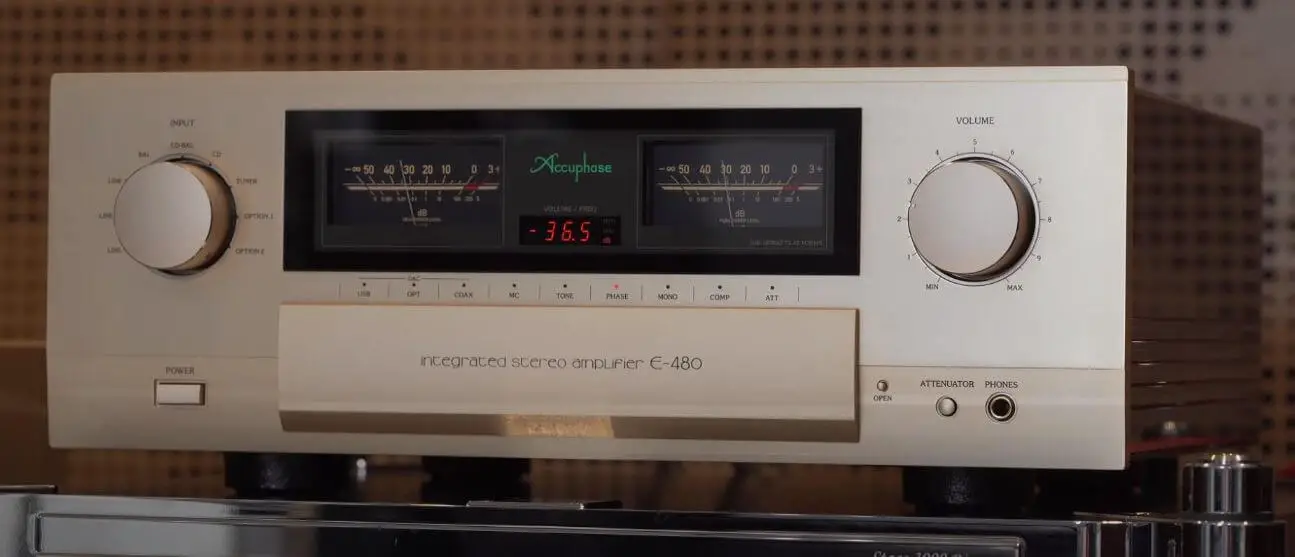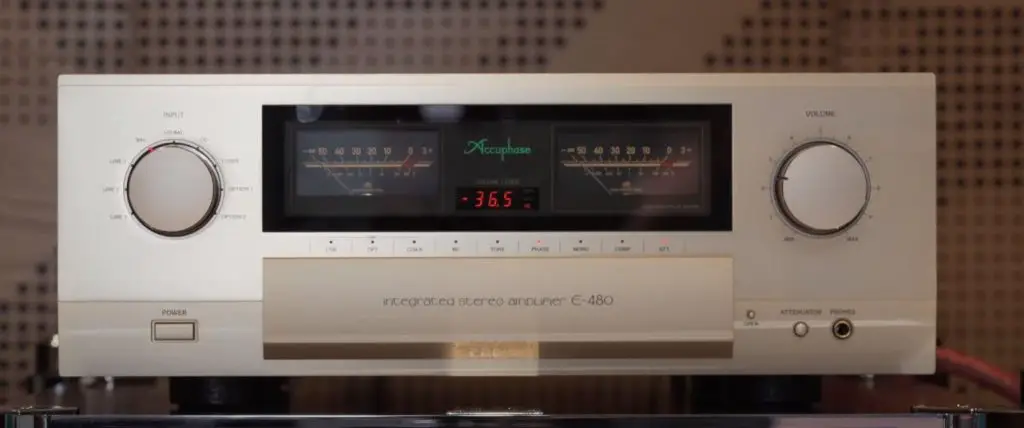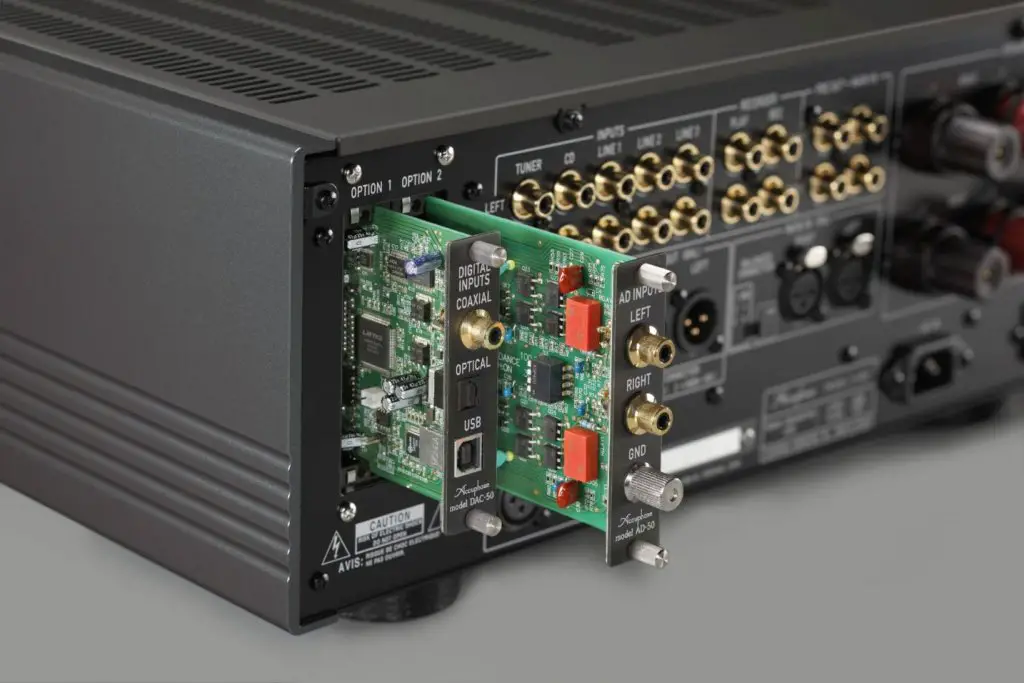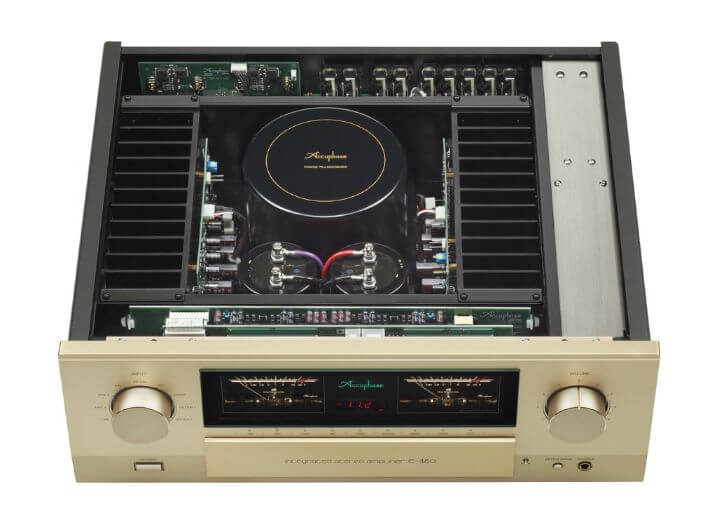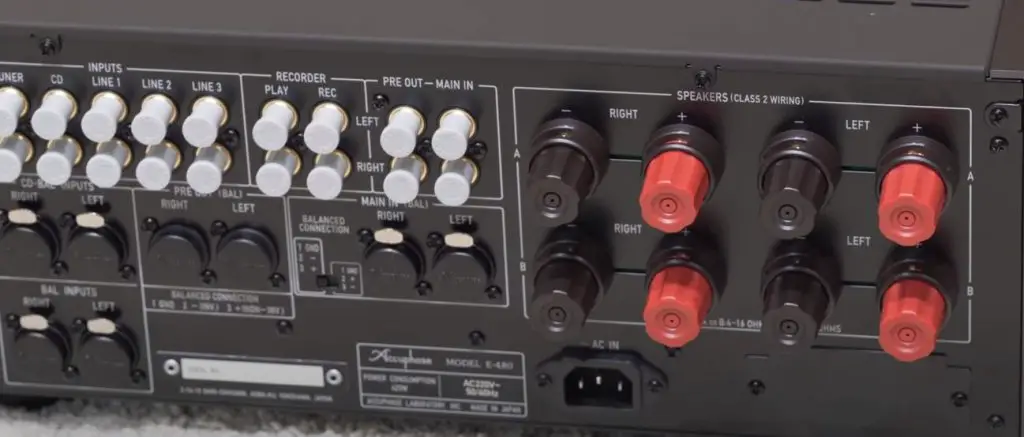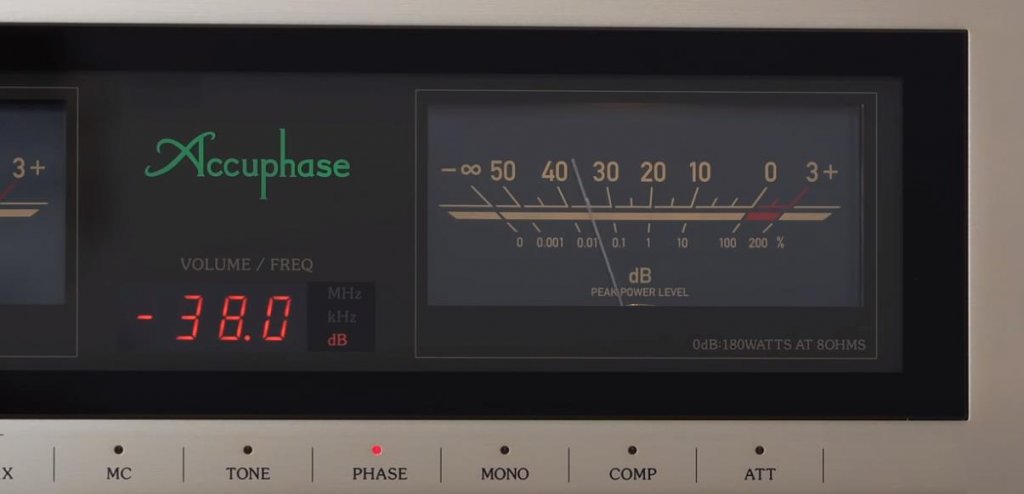Accuphase E480 Integrated Amplifier Review
This post will review something very important, a Japanese national treasure, top of Hi-End brands in Japan, Accuphase, and their latest integrated amplifier E-480. It is a very significant item in the Hi-Fi circle. The Accuphase E-480 is classical integrated amps with revolutionary AAVA volume control. Like with all Accuphase products, it’s built like a fine mechanical watch.
Design of Accuphase E480
First, let’s take a closer look at what you get with the E480—starting with the front of the panel. We have these beautiful display meters, the peak power meters, which is what Accuphase calls. They are so sensitive that they’ll respond to input as low as negative 60 dB. Besides the analog meter, You have the digital volume readout. The VU meters for the Accuphase E-650, their flagship Class A integrated amplifier, incorporated a new design for the sound pressure display using LEDs. It also looks good. It is the LED display used in other traditional Japanese audio products. But I think the analog dials look better. So, for me, this amp has the most beautiful analog meter display. It is a very high visual enjoyment.
From left to right, we have our input selector knob, and as you would expect, it has a lot of resistance, the satisfying click when you switch between inputs. We have our power button and the signature Accuphase panel. There are a lot of buttons and switches here. You can bi-wire from this amplifier with the A/B selector switch if you want.
We have the tone controls, bass, and treble. The bass is set to 300 hertz the treble set the three kilohertz. But the adjustments will not affect the sound until you press tone (activation). When “Tone Control” lights up, you can listen and adjust the tonal balance. Is this useful? Yes, very useful. On many products turning on those tone controls will lower the sound quality. With Tone Controls in the signal path, they will increase the distortion of the signal. But that does not appear to be the case on the Accuphase. With their tone controls engaged, it’s tough to hear any signal distortion. When I listened to this integrated amplifier, whenever I activated the tone control circuit, I actually heard no audible difference between the circuit is activated and it is being off. Typically you can hear that tone control circuit from other amplifiers.
Also, you have a button for a DAC, moving magnet/moving coil phone stage. Also, we have a button to invert phase, which is pretty useful. Comp button is another way of saying loudness. This “Comp” (compensate) button is straightforward. It will augment the bass with it on at low volumes. Some people think that touch more bass will give a warmer balance. At low volume, “Comp” (Compensate) adds a layer of bass. The last item on this panel is a Headphone Jack, which is very Hi-End too. It is in Class A mode.
The Rear of Accuphase E480
Let’s have a look at the back first IEC power plug. Near the bottom, Large speaker terminals, two sets for A/B speakers. Usually, you would only use one group of A or B speakers at a time. Multiple sets of analog inputs, including five sets of RCA stereo inputs. 2 more sets of stereo balanced analog inputs, one is “Balance Inputs,” and the other is “CD-Balance Inputs.” Besides, there are also some very lovely inputs and outputs. You can see the “Pre Out” and “Main In.” What are they for? The “Pre Out” is for you adding a different amp. You can use the preamp section of the E-480 from this. If you only want to use the E480 as a power amp, you can connect to “Main In.” This allows you to use the E-480 only as a pre or power amp. More importantly, whether it is the “Pre Out” or “Main In,” it is available for both RCA and balanced terminals.
The connectivity of this amp is very flexible. There are two optional card slots on the left side in the back of the E-480 for two different option cards. What kind of option cards can I install? There is the phono stage card for vinyl playback or the DAC card for digital decoding, adding a high-quality built-in phono stage. It doesn’t come built-in, and some people are going to react negatively to this. For me, I don’t mind because I’m the kind of person that I rarely use built-in DAC and phono stages. Anyways so it’s nice to have the option to add them from Accuphase if you want. But if you don’t, then you’re not paying for something that you’ll never need.
The Inside of Accuphase E480
Let’s take a peek at the inside of the Accuphase E480. I got to admit it’s as clean organized and as well made as I expected it to be. With each circuit being isolated via aluminum compartment spaces. Speaking of isolation, the pre-amplifier, which you can notice on the very left-hand side, is about as shielded as it gets. In the center, we have our shielded toroidal transformer. Next to that, we have our two filter caps, which are rated at 40,000μF apiece. This integrated amplifier uses MOSFETs, specifically in a triple parallel push-pull configuration. You may notice the perforated bottom, and this is to help with heat dissipation.
The Features
Is its power is enough? It has 180 watts (Class AB), into 8 Ohms for 4 Ohms, up to 260 watts. There is a total capacitance of 40,000μF for the power supply. It should be more than able to handle most of the speakers out there.
The pre-amplifier gain and volume control are made very differently compared with other brands. Accuphase employs a proprietary Pure analog AAVA (Accuphase Analog Vari-gain Amplifier) Volume Control. How the volume gets higher or lower inside depends on a proprietary fully analog, fully balanced, fully symmetrical line amplification gain stage. Most other preamps design in the world uses attenuation to control volume. But Accuphase, they designed their AAVA system to vary gain for volume control.
Moreover, each step of the volume is accurately matched to the impedance and frequency response. In other words, the distortion for each level is kept to as low as possible. The difference in volume between the Left and Right channels are also kept as low as possible. With this proprietary design element, the preamps in all of Accuphase amplifiers have very low distortions. Therefore, even the most delicate details of the sound can be heard with no problems.
Sound Performance
The E-480 has more than enough power, and the bass was abundant. In fact, for many years, Accuphase has been known for its smooth and detailed performance, unlike the American counterparts, where heavy punching and flooding you with waves of sound. Its tuning is more towards elegant music appreciation, with rich details. On many integrated amps, the manufacturers would usually cut costs on the preamp section. This is not the case here. Its preamp section is excellent, and the sound is full.
At various SPLs, whether it is whispering, loud, or medium, Its soundstage and tonal clarity performances are both very linear and stable. This is another very important factor because not everyone has his/her listening studio. In most cases, when you get home after work, you can’t listen too loudly in the evenings either. For the E480 amplifier, to have a consistent sound quality and control on the speakers at all playback levels. Not many amplifiers can do that.
Accuphase has a reputation for producing components that have always had this agreeable sounding presentation, just very pleasant to the ear. Usually through giving you an immense sense of scale, a warm and rich sounding mid-range, and treble that honestly varies from unity in it. Sometimes it’s neutral. Sometimes, it’s rolled off. Sometimes it’s lively. The E480 is more of a neutral sounding component, something that’s all about transparency, something that’s designed to show you precisely what you’re recording sound like and to showcase what your speakers sound like.
There are many amplifiers out there that have more of what people would call a lively presentation. Usually, this means the treble’s boosted up or very least prominent. Usually, the sound of those amplifiers is rapid, straightforward, dynamic. The E480, on the other side, is going to be more warm and full-bodied with a treble that isn’t going to be aggressively voiced. I would say that the e480 falls ever so slightly towards the warm side of neutral. You’re going to experience that the most within the mid-range because that’s where you’re going to find not only that immense sense of scale, but you’re going to find that body, that warmth, and that richness that gives this unit a great sense of tone and depth.
The Treble Performance
As I just mentioned, E480 is open spacious, effortlessly detailed. It has a great tone. But how you interpret the treble will depend on what you’re coming from? For example, if you’re coming from bright sounding amplifiers, then stepping to an Accuphase product, you may feel kind of tame in the high-frequency. If you have forward sounding speakers and you’re going to hear a slightly forward sounding presentation, mostly if you listen to less than perfect recordings. But if you have more neutral to smooth sounding speakers, that’s likely what you’re going to get out of the high-frequency of this unit.
The Mid-range Performance
We move on to the mid-range, which to me, is where the magic happens. Why so many people love Accufase is because it’s a gorgeous sounding mid-range. The tonal saturation of just about every music that you listen to sounds delightful. But that doesn’t mean it only sounds good with audiophile music because this amplifier has a lot of power to it. There’s some muscle there. Because of the depth of the sound, it goes well with just about any genre of music. I listen to a lot of metal rock and roll, listen to hip hop, listen to heavy bass music and mid-range heavy music, and the E480 amplifier does a great job.
The Bass Performance
It does take on this warm and robust sound. The most significant change in this E-480 is that Damping Factor is further increased by 20%. The damping Factor is now up to 600, improving the damping factor. The E-480 can handle speakers that need control better. This content is originated from hifireport.com.
Speakers to Match
Let’s focus on the kind of speakers that sound good with the Accuphase E480. This is a very powerful integrated amplifier. It’s going to accommodate most rooms and most listening habits very well, whether you’re somebody who listens to soft volumes or somebody who listens to loud volumes. It almost doesn’t even matter what kind of speakers you own because it has the kind of presentation that seems to work with everything. You get that warmth and that density within the mid-range. You get treble that’s revealing. It has some sparkle to it, but it’s not over the top, nor is it too rolled off, meaning that it doesn’t matter what you own, KEF, B&W, Dynaudio, Focal, and the list goes on and on. Odds are they’re going to sound pretty good with this integrated amplifier. I think that’s why Accuphase is so universally respected in this industry.
Conclusion
I like this integrated amplifier, Accuphase E480 Amplifier. I think it has a very pleasing presentation.
It is all about balance. It does have that warmth within the mid-range: the bass and treble. That’s neither too forward nor too laid back. The Accuphase is much more transparent sounding. In other words, it’s more revealing. You’re going to hear more of what’s really on your recordings. Because it’s so capable, it will better showcase what your speakers themselves are capable of.
That will be the resolution, the detail which is far superior to the refinement, particularly within the treble. How spacious and airy it is. The sound stage’s width, then you have the mid-range, the sense of scale and body within the Accuphase is much larger with a richer tonal palette, a more accurate tonal palette. And then you have the base. It’s stronger yet, at the same time, more controlled.
If you’re very passionate and you have the money, it could be worth the upgrade.
